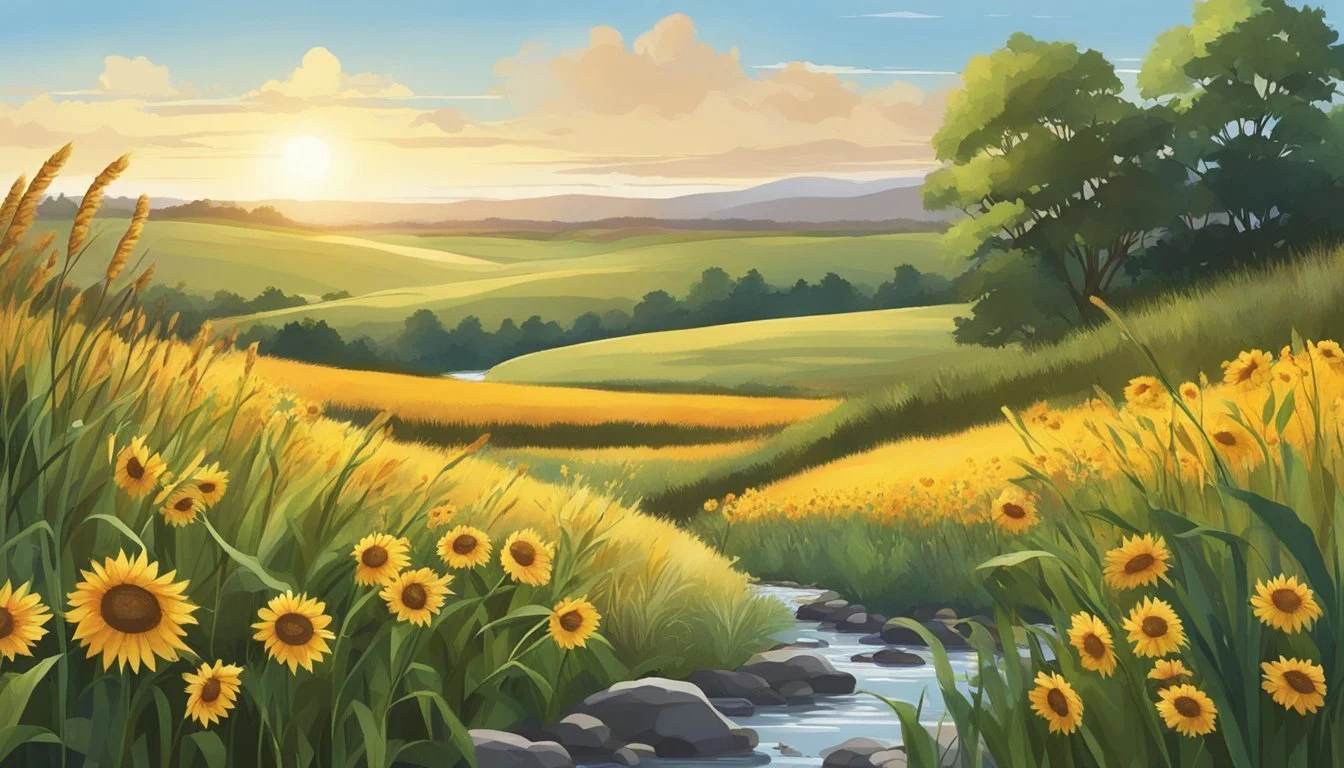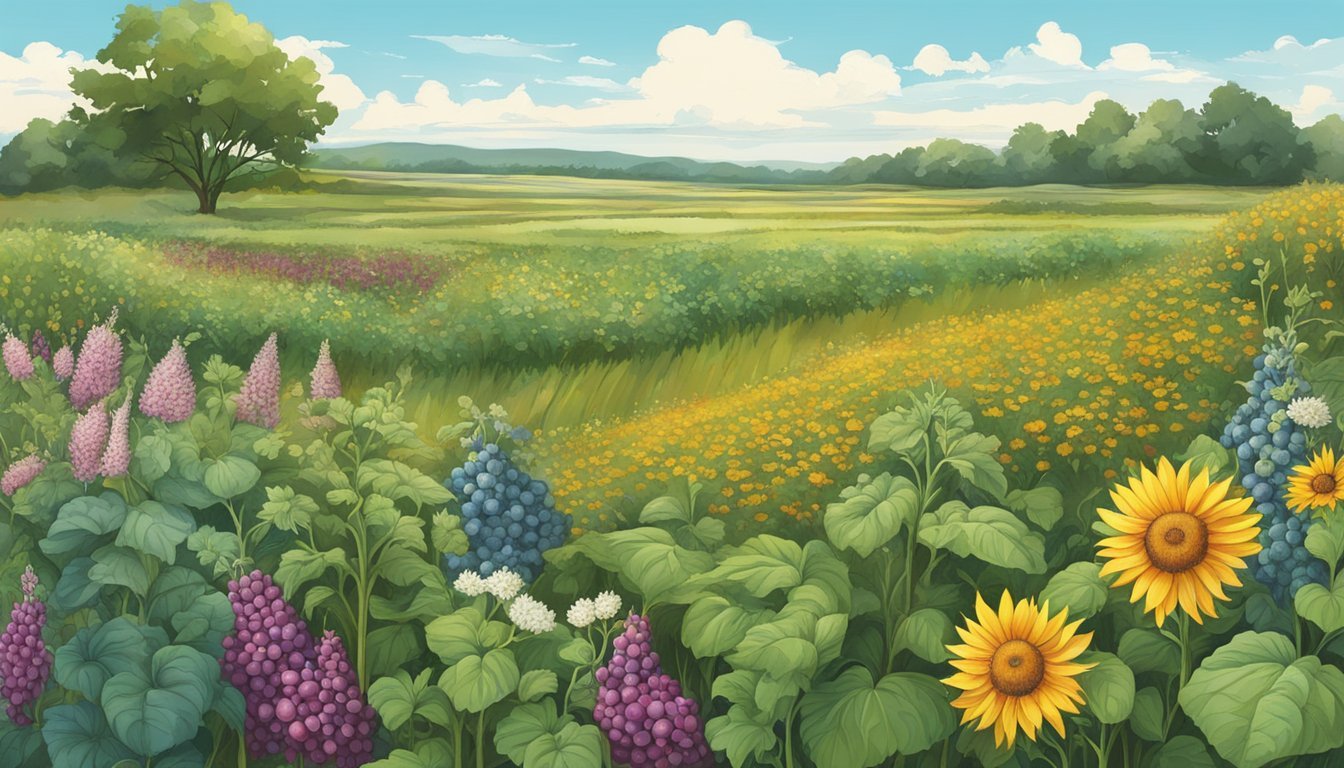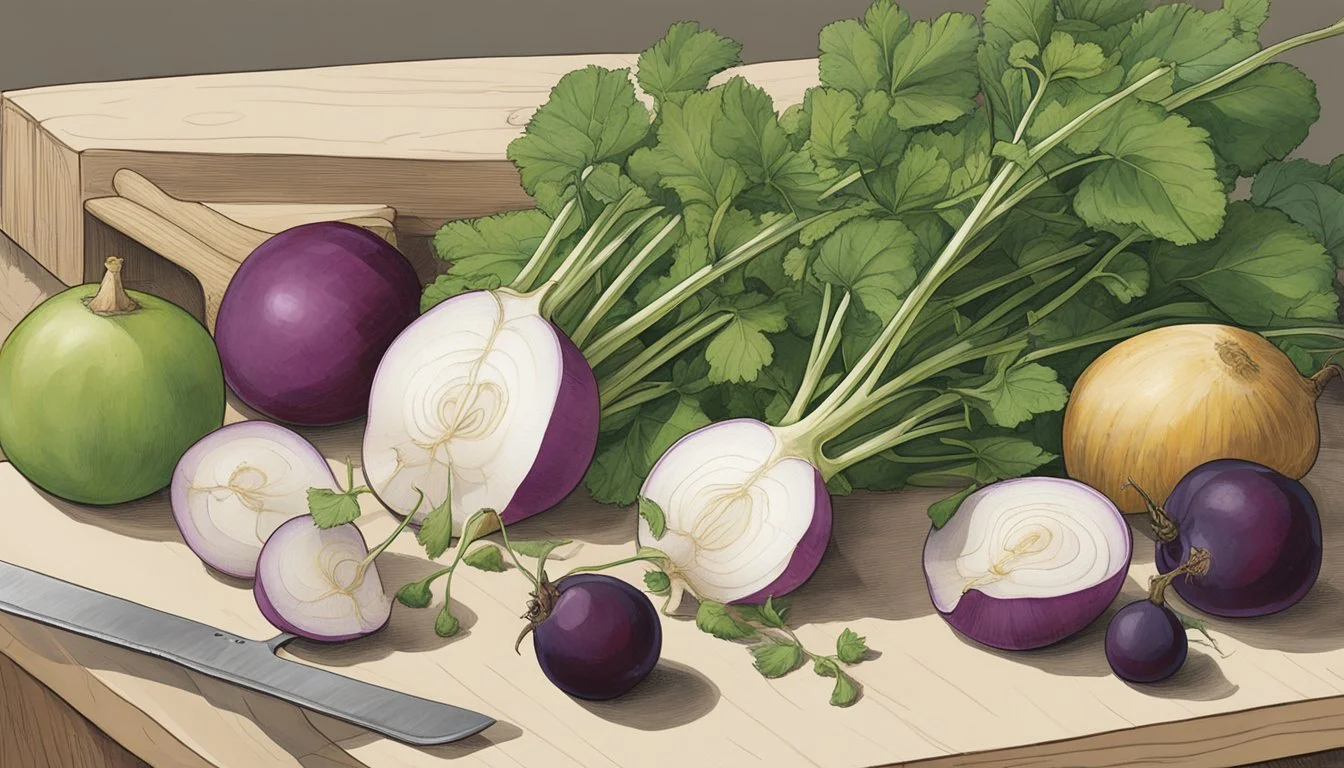Central Plains Native Edible Plants
A Guide to Regional Foraging
The Central Plains region of North America is a treasure trove of native edible plants that offer both sustenance and a connection to the land's natural history. From the American groundnut, Apios americana, which yields tasty tubers similar to baby potatoes, to the versatile dewberry, resembling blackberries, these plants provide valuable and nutritious food sources. Understanding these native species and their uses can transform any foraging outing or garden into a sustainable and enriching experience.
One such plant is the American cranberry, found in northeastern North America's bogs. This plant thrives in cool, moist, and acidic conditions and can be grown at home with the right soil and climate. The cranberry is not only a traditional fruit associated with many dishes but also a fantastic addition to home gardens aiming for native plant diversity.
In Central Texas, edible native plants like the Mexican plum and Agarita (Mahonia trifoliolata) add both beauty and utility to the landscape. These plants are well-suited to the region's climate and provide a variety of flavors and nutrients, making them excellent choices for those looking to cultivate a garden rich in heritage and practicality.
Understanding the Central Plains Region
The Central Plains region spans a significant portion of the United States, encompassing areas such as Texas and extending into parts of Montana. This area is characterized by its diverse climate and various habitats, which support a rich flora of native plants, including wildflowers, trees, shrubs, and grasses.
Geography and Climate
The Central Plains stretch over a broad area of the central United States, including regions from Texas to Montana. This expanse features flatlands, rolling hills, and river valleys.
The climate is primarily continental, with hot summers and cold winters. Rainfall varies substantially, with eastern areas receiving more precipitation compared to the drier western parts.
Severe weather, such as tornadoes, can frequently occur here, particularly in spring and early summer. Despite the extremes, the climate supports a broad range of habitats, from prairies to woodlands, creating a rich environment for many plant species.
Flora of the Central Plains
The flora of the Central Plains is diverse, adapted to the region's varying climates and habitats. Wildflowers, such as the prairie coneflower and Blazing Star, provide colorful displays during spring and summer.
Trees in this region include sturdy species like the bur oak and cottonwood, which thrive in the challenging climate. Shrubs such as the chokecherry offer edible fruits and have been part of the human diet for centuries.
Grasses, including buffalo grass and big bluestem, dominate the prairies and are crucial for maintaining the ecological balance. These plants provide essential habitats for wildlife and play a significant role in soil preservation.
Native Edible Plants Overview
Central Plains native plants offer significant cultural, nutritional, and medicinal benefits. These plants have deep historical ties and provide an indispensable resource for sustenance and health.
Historical Significance
The Central Plains Native American tribes relied heavily on the native flora for survival. Key plants included the American bison-diet companion foods such as wild fruits and tubers.
Chokecherry fruits were used extensively in traditional dishes. The tribes also harvested Indian potato tubers, providing a starchy food source rich in carbohydrates. These plants did not merely serve dietary needs but were integral to cultural practices and ceremonies.
Pine nuts provided essential proteins and fats. Foraging and cultivating these plants helped maintain local ecosystems and biodiversity.
Nutritional and Medicinal Benefits
These plants offer significant nutritional value. Indian potato tubers, for example, are rich in starch, making them excellent for energy. Pine nuts offer a source of protein and healthy fats, essential for a balanced diet.
Chokecherry fruits are high in antioxidants and vitamins such as Vitamin C, supporting immune health.
Medicinally, chokecherries were used to treat various ailments like coughs and sore throats. The diverse nutritional profiles helped meet dietary needs; medicinal uses managed health conditions. Understanding these benefits highlights the importance of integrating native edible plants into modern health practices.
Plant Identification Techniques
Accurately identifying native edible plants in the Central Plains involves examining several key plant parts, such as the leaves, stems, seeds, and roots. Understanding these components ensures safe and sustainable foraging.
Leaf and Stem Analysis
Leaf and stem characteristics are crucial for plant identification. Leaves vary in shape, size, margin, and arrangement. For example, the sand plum (Chickasaw plum) has simple, oval leaves with serrated edges.
Stems also offer clues, including texture and color. Some stems are smooth, hairy, or woody, which can distinguish between similar species. Observing any unique markings or patterns aids in accurate identification.
Seed and Root Examination
Seeds and roots provide additional confirmation. For instance, the Pawpaw has large, bean-shaped seeds that are a distinctive trait. Analyzing the size, shape, and color of seeds can differentiate between edible and toxic species.
Roots are equally informative. Wild onions have bulbous, onion-like roots which are easy to recognize. Digging up the roots to inspect their form and structure helps ensure the plant is correctly identified and safe to consume.
Top Native Edible Plants
The Central Plains region offers a variety of native plants that are both nutritious and flavorful. This section will explore some of the most notable edible plants, highlighting key details about fruits, roots, and leafy greens.
Foraging for Fruits and Berries
The Central Plains host a range of edible fruits and berries. Pawpaw (Asimina triloba), known for its creamy texture and banana-like flavor, is a standout. It thrives in well-drained soil and slight shade. Another notable fruit is the wild persimmon (Diospyros virginiana), which requires frost to fully ripen and sweeten.
Blackberries (Rubus spp.) are easy to identify and abundant in the region. They can be found in sunny spots with well-drained soil and are usually ripe for picking in mid-summer. Dewberries, similar to blackberries, grow low to the ground and ripen slightly earlier.
Roots and Tubers
Several roots and tubers in the Central Plains are both edible and nutritious. Jerusalem artichokes (Helianthus tuberosus), also known as sunchokes, are prized for their nutty flavor and can be cooked in various ways. They prefer well-drained soil and can be harvested in fall.
Wild onions (Allium spp.) are another essential root vegetable. They have a strong flavor akin to cultivated onions and can be used similarly in cooking. Look for them in moist, shady areas.
Dandelion roots (Taraxacum officinale) are often overlooked but can be roasted and used as a coffee substitute or cooked as a vegetable. They are easy to identify by their characteristic yellow flowers and jagged leaves.
Leafy Greens and Herbs
Leafy greens and herbs such as ramps (Allium tricoccum) and wild onions are crucial for adding flavor and nutrients. Ramps are highly sought after for their garlicky taste and can be found in moist, wooded areas. Harvest them carefully to ensure sustainable growth.
Violets (Viola spp.) provide edible leaves and flowers that can be added to salads. Look for them in shaded, grassy areas. They offer a mild flavor and a touch of color to dishes.
Dandelion greens are rich in vitamins and can be used in salads, soups, or sautéed. Their slightly bitter taste pairs well with a range of ingredients, making them versatile and valuable.
These native plants offer a sustainable and nutritious way to explore the local flora of the Central Plains. They provide valuable sources of food and connect foragers with their natural environment.
Environmental Considerations for Harvesting
When harvesting native edible plants in the Central Plains, it is crucial to consider the sustainability of practices, the impact on local wildlife and insects, and how to adapt to changing weather patterns.
Sustainable Foraging Practices
Engaging in sustainable foraging practices is vital to maintaining ecological balance. Foragers should refrain from overharvesting; only a portion of the plants should be taken so that the population can replenish. Native species such as the Pawpaw or sand plum should be harvested minimally.
Leave a share of the plants for the wildlife that depends on them, and ensure you're familiar with local regulations to avoid legal complications. Rotating harvest areas can prevent the depletion of plant populations and promote healthy ecosystems.
Impact on Local Wildlife and Insects
Harvesting activities can significantly impact local wildlife and insects. Many native plants serve as food sources for creatures ranging from small insects to larger animals. For example, native bees rely on flowers like the wild onion for nectar, while prickly pears provide sustenance for small mammals.
Disturbing these plants can disrupt their food chains. Foragers must be mindful of not damaging habitats, which can have cascading effects on the ecosystem. Avoid using tools that can harm insects like bees, and always harvest with consideration for the animal communities around the plants.
Adapting to Weather Patterns
Weather patterns in the Central Plains, including wind and drought conditions, can affect the availability and health of native plants. Drought-tolerant species such as the Chickasaw plum should be prioritized, as they are more resilient to climate variations.
It is also important to time harvesting activities to coincide with favorable weather conditions. This not only ensures better yield but also reduces stress on the plants during critical growth periods. Monitoring local weather forecasts and understanding seasonal patterns will help foragers make informed decisions, ensuring that the environment remains balanced and productive.
Gardening with Native Edible Plants
Growing native edible plants in the Central Plains not only provides a sustainable source of fresh produce but also supports local wildlife and reduces garden maintenance. Key considerations include creating a low-maintenance garden, encouraging pollinators, and choosing the right plants for various garden spaces.
Designing a Low-Maintenance Garden
Designing a low-maintenance garden starts with selecting native plants adapted to the local environment. These plants are naturally resistant to regional pests and diseases, reducing the need for chemical interventions.
Drought-tolerant species like Blue Wild Indigo (Baptisia australis) and Coneflower (Echinacea purpurea) require minimal watering once established. Incorporating mulch helps retain soil moisture and suppress weeds, further lowering maintenance.
Grouping plants with similar water and sunlight requirements simplifies the care routine. Raised beds or container gardens can also streamline planting and harvesting, making gardening more accessible and less labor-intensive.
Attracting Pollinators
Attracting pollinators is crucial for the health and productivity of an edible garden. Native plants like Spiderwort (Tradescantia), Blue Wild Indigo, and Coneflower provide essential nectar and pollen.
Creating a habitat for native bees, butterflies, and hummingbirds involves planting a variety of blooms that offer continuous flowering throughout the growing season.
Key Plants for Pollinators:
Spiderwort (Tradescantia)
Coneflower (Echinacea purpurea)
Blue Wild Indigo (Baptisia australis)
Providing water, such as a shallow birdbath, and avoiding pesticides also benefits these beneficial insects, ensuring effective pollination and a productive garden.
Plants for Different Garden Spaces
Selecting the right plants for different garden spaces ensures that each area of the garden thrives. Coneflower and Blue Wild Indigo do well in sunny spots, offering vibrant colors and edible parts.
For partially shaded areas, Wild Strawberries (Fragaria virginiana) and Pawpaw Trees (Asimina triloba) are excellent choices. These plants provide fruits and require less direct sunlight.
Tall plants like Sunflowers (Helianthus annuus) can be utilized at the back of garden beds or along fences, while sprawling plants such as Ground Cherries (Physalis) fit well in ground cover areas or hanging baskets.
Consider creating layers with varying heights and growth habits to maximize space and visual appeal, ensuring a well-structured and productive garden year-round.
Culinary Uses and Preparation
Native edible plants of the Central Plains offer a variety of culinary applications, from traditional recipes to modern innovations, and have been preserved through various methods for long-term use.
Traditional and Modern Recipes
Historically, the sand plum, or Chickasaw plum, and the wild onions were staples in local diets. The sand plum can be used for jams, jellies, and syrups. Wild onions add flavor to soups and stews, similar to chives or green onions.
Modern recipes incorporate Pawpaw fruit in smoothies, breads, and ice cream. Its tropical flavor makes it a versatile sweet ingredient. Chokecherry also remains popular for preserves and syrups, but contemporary dishes include chokecherry sauces for meats or desserts.
Preservation and Storage
Native edible plants are often preserved through drying or freezing. Chokecherries are dried to be used in soups or cereals and can be mixed with bison meat as per traditional practices. Dried products can be stored for months, maintaining their nutritional value.
Jams, jellies, and syrups from sand plums and chokecherries are canned, ensuring they remain edible for extended periods. Freezing is another essential method, particularly for Pawpaw fruit, which can be peeled, chopped, and stored in airtight containers. This approach preserves both texture and flavor.
Conservation and Ethical Considerations
In the Central Plains, conservation efforts and ethical considerations are vital for protecting native edible plants. These efforts focus on preserving species through habitat protection and understanding legal frameworks that regulate harvesting.
Protecting Native Species
Protecting native species involves conservation practices aimed at maintaining the biodiversity of the region. This can include actions such as habitat restoration, controlled burns, and invasive species management.
Habitat destruction is a major threat to these plants. Practices like sustainable foraging can help minimize human impact. For instance, avoiding large groups during foraging and not creating new trails helps preserve the ecosystem.
To further ensure ethical harvesting, foragers should follow guidelines to avoid over-collection. This promotes the regeneration of native plants and the overall health of the habitat.
Legal Frameworks and Restrictions
Regulations regarding the harvesting of native plants vary. It is crucial to understand local, state, and federal laws to ensure compliance and the protection of natural resources.
Environmental laws prohibit the collection of certain species or set limits on quantities that can be harvested. These laws help prevent overharvesting and ensure long-term sustainability.
Ethical considerations include respecting private properties and protected areas. Foragers should always seek permission before collecting plants and adhere to any posted restrictions.
By following these legal frameworks and respecting ethical guidelines, individuals contribute to the conservation of native plants in the Central Plains. This helps maintain their ecological role and availability for future generations.









